


xxxxxThe Confederate army won The First Battle of Bull Run in June 1861 (Va), and gained a further victory at the Second Battle of Bull Run in August 1862. An attempt the following month to seize the Union capital, Washington, ended in a defeat for the Southerners at the Battle of Antietam, but they gained another major victory at the Battle of Fredericksburg before the winter set in. Meanwhile in the west the Union forces proved much more successful under General Ulysses Grant. They seized Confederate strongholds in Tennessee, and won the Battle of Shiloh in April 1862. By June, Memphis, Corinth and New Orleans had been taken, and Grant’s victory at the Battle of Vicksburg meant that the Confederation had been split down the middle, north to south. The resumption of fighting in the east in April 1863 led to a Unionist defeat at the Battle of Chancellorsville, Virginia, but, as we shall see, the Unionists were to win a decisive victory at the Battle of Gettysburg in Pennsylvania in July 1863. The War at Sea centred around the Union blockade of southern ports, and this proved generally successful. The major event of the conflict was the battle between the two warships, the Unionist Monitor and the Confederate Virginia, in January 1862. It proved inconclusive, but it was the first naval battle to be fought between ironclads.
THE AMERICAN CIVIL WAR
THE SECOND BATTLE OF BULL RUN 1862 (Vb)
Acknowledgements
Map (Eastern
Campaign): from forourfamily.info/Map. Encounter:
lithograph produced by the Boston printing company Louis Prang
& Co. in 1886, the work of the American marine artist Julian
Oliver Davidson (1853-
xxxxxAs we have seen, the
Confederate army won the opening battle of the American Civil War.
In June 1861 (Va)
it gained a victory over a Union force at the First Battle of Bull
Run -
xxxxxThen at the end of August the Army of the
Potomac, this time led by General John Pope, was again defeated.
The Confederate general Thomas Jonathan “Stonewall” Jackson,
having weakened Pope’s forces by a series of cavalry attacks, met
him head on at the Second Battle of Bull Run in August 1862.
At first the Union appeared to have the advantage but, once again,
Jackson stood his ground until the arrival of reinforcements under
the command of Generals Lee and Longstreet. The 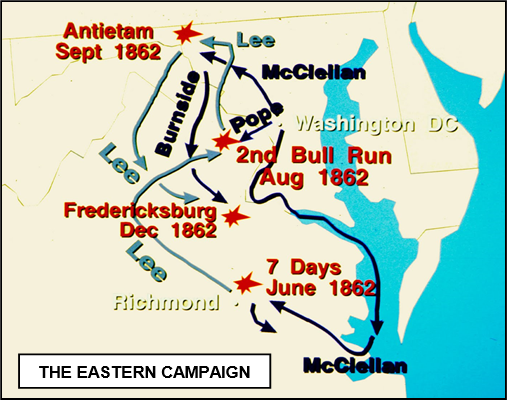 following
day the
Confederates took
the offensive and, due in part to Pope’s indecisiveness, quickly
gained the upper hand. Out manoeuvred, the Union forces fled the
field and made for the safety of Washington, thirty miles to the
north, leaving behind some 14,000 dead or wounded.
following
day the
Confederates took
the offensive and, due in part to Pope’s indecisiveness, quickly
gained the upper hand. Out manoeuvred, the Union forces fled the
field and made for the safety of Washington, thirty miles to the
north, leaving behind some 14,000 dead or wounded.
xxxxxHavingxdriven the Unionists out of Virginia, Lee then moved
into Maryland, bent on capturing Washington, the Federal capital.
Here, however, his advance was checked at the Battle
of Antietam (or Sharpsburg) in September
1862. By this encounter, one of the bloodiest battles of the civil
war, Lee was forced to retreat into Virginia, but the Unionist
General McClellan did not press home his advantage, and was
summarily dismissed. Hisxsuccessor, General Ambrose E. Burnside
(1824-
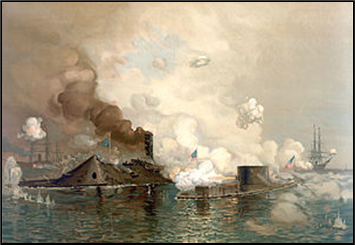 xxxxxThe War at Sea was centred around the Federal blockade of the
southern ports from Virginia to Texas. For the most part this
blockade was successful, but one incident is worthy of mention. In
order to strengthen this stranglehold on the import of war
supplies and the export of raw materials, in January 1862 the
Union launched its revolutionary warship Monitor.
The invention of the Swedish-
xxxxxThe War at Sea was centred around the Federal blockade of the
southern ports from Virginia to Texas. For the most part this
blockade was successful, but one incident is worthy of mention. In
order to strengthen this stranglehold on the import of war
supplies and the export of raw materials, in January 1862 the
Union launched its revolutionary warship Monitor.
The invention of the Swedish-
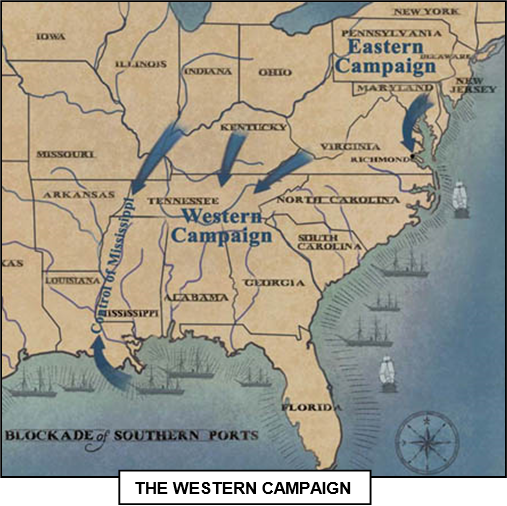 xxxxxAs we have seen, in the opening phase of the war in
the East, the
Confederate forces had more than held their own. In the West, however, it was a very
different story. Havingxsecured the
border states of Missouri and Kentucky, a Union army entered
Tennessee in February 1862 and, under the command of General Ulysses S. Grant (1822-
xxxxxAs we have seen, in the opening phase of the war in
the East, the
Confederate forces had more than held their own. In the West, however, it was a very
different story. Havingxsecured the
border states of Missouri and Kentucky, a Union army entered
Tennessee in February 1862 and, under the command of General Ulysses S. Grant (1822-
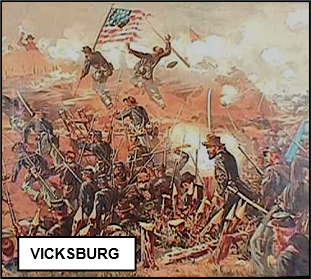 xxxxxSeptember saw Lincoln’s
momentous proclamation abolishing slavery in the Confederate
States -
xxxxxSeptember saw Lincoln’s
momentous proclamation abolishing slavery in the Confederate
States -
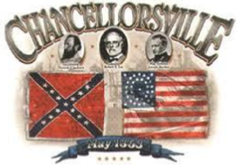
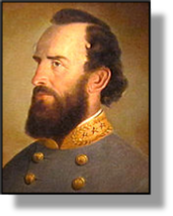 xxxxxInxthe meantime the war had
resumed in the east. The newly appointed Union commander, General
Hooker, took the offensive in April 1863. Having crossed the
Rappahannock River early in May, he attempted to encircle the
Confederate army at Chancellorsville, Virginia, but, unaware of General Lee’s movements,
he was himself outmanoeuvred and forced to retreat with heavy
loses, estimated at over 17,000. In comparison,
the Southerners lost only 12,000 men, but amongst them was General
“Stonewall” Jackson, one of the Confederate’s most able commanders
(illustrated).
While visiting his troops he was accidentally shot by one of his own
camp guards, and died a week later.
xxxxxInxthe meantime the war had
resumed in the east. The newly appointed Union commander, General
Hooker, took the offensive in April 1863. Having crossed the
Rappahannock River early in May, he attempted to encircle the
Confederate army at Chancellorsville, Virginia, but, unaware of General Lee’s movements,
he was himself outmanoeuvred and forced to retreat with heavy
loses, estimated at over 17,000. In comparison,
the Southerners lost only 12,000 men, but amongst them was General
“Stonewall” Jackson, one of the Confederate’s most able commanders
(illustrated).
While visiting his troops he was accidentally shot by one of his own
camp guards, and died a week later.
xxxxxThe defeat at Chancellorsville was a serious blow to the Unionists, but they were to reap their revenge in a matter of weeks. In order to draw the Federal forces out of Virginia, in June General Lee again crossed the Potomac and invaded Maryland. As we shall see, at the beginning of July 1863 he met up with the enemy at Gettysburg, a town in Pennsylvania just north of the Maryland border. The battle that ensued, one of the bloodiest engagements of the civil war, was to prove a decisive turning point in the conflict.
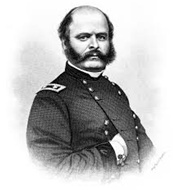 xxxxxIncidentally, the Union
commander Ambrose Everett Burnside did not distinguish himself
during the war, but his distinctive side whiskers were much
admired, and many men adopted these “burnsides” or “sideburns”. ……
xxxxxIncidentally, the Union
commander Ambrose Everett Burnside did not distinguish himself
during the war, but his distinctive side whiskers were much
admired, and many men adopted these “burnsides” or “sideburns”. ……
xxxxx…… In the South the First and Second Battles of Bull Run were known as the First and Second Battles of Manassas. ……
xxxxx…… After its famous
encounter with the ironclad Virginia in
March 1862, the Union warship Monitor -
Including:
The War at Sea
and Winslow Homer

xxxxxSoon after
the Civil War broke out, the American printmaker and painter Winslow Homer (1836-
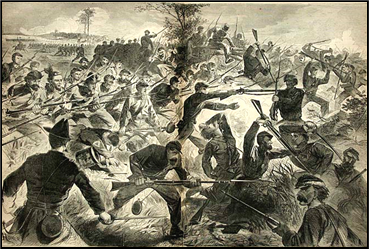 xxxxxThe Bayonet Charge,
published in Harper’s Weekly in July
1962 (here illustrated), was the work of the American printmaker and painter
Winslow Homer (1836-
xxxxxThe Bayonet Charge,
published in Harper’s Weekly in July
1962 (here illustrated), was the work of the American printmaker and painter
Winslow Homer (1836-
xxxxxIn 1867,
based in New York, Homer turned to painting in oil and
watercolour. To master these new techniques he produced a series
of works depicting everyday scenes -
xxxxxIn the
early 1880s Homer visited England and spent close on two years at
the small fishing village of Cullercoats in the north of the
country. This reawakened his love of the sea and, on his return,
he settled at Prout’s Neck, Maine, just a few yards from the
Atlantic Ocean. Here he produced the marine subjects -

xxxxxTowards the
end of his career Homer spent some time abroad, travelling to the
Caribbean and Canada during the winter, or painting and fishing in
the Adirondacks Mountains, New York State, over the summer months.
There, as at Prout’s Neck, he proved a remarkable exponent of
realism, based on direct observation and achieved by a close
regard to composition and the handling of light and shade. During
his career he produced some 600 works. His watercolours, in
particular -
Vb-


